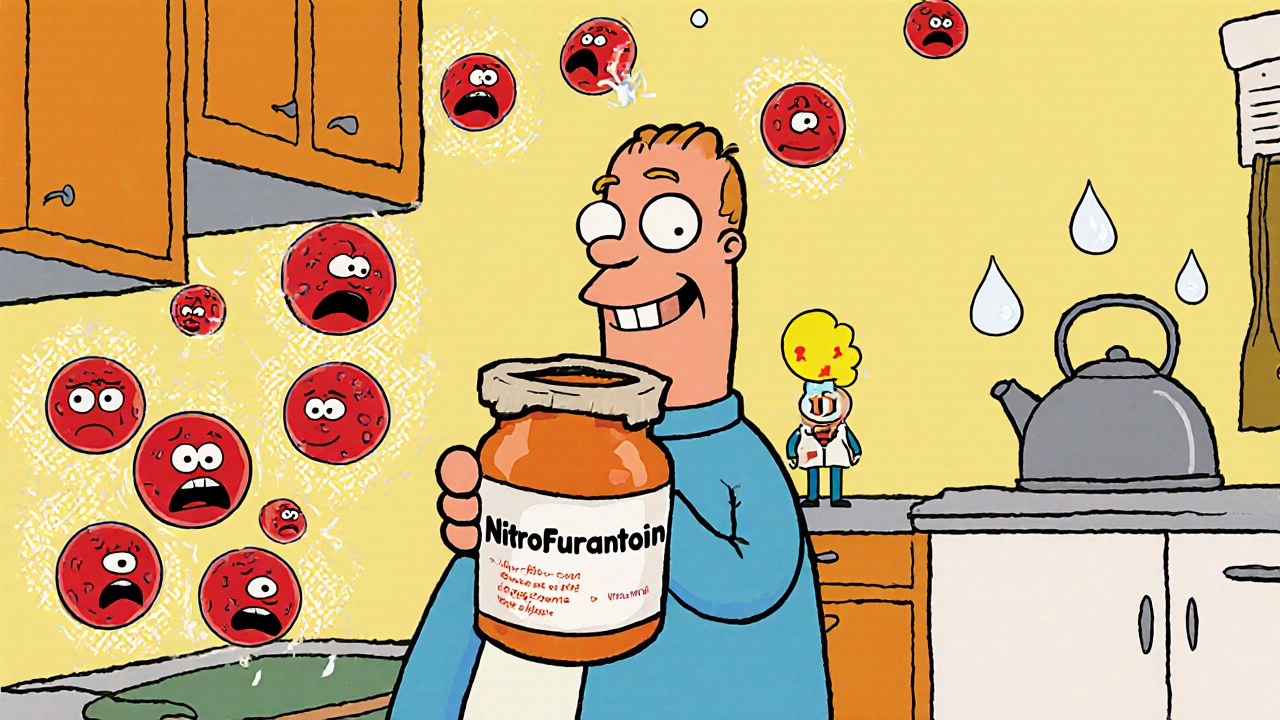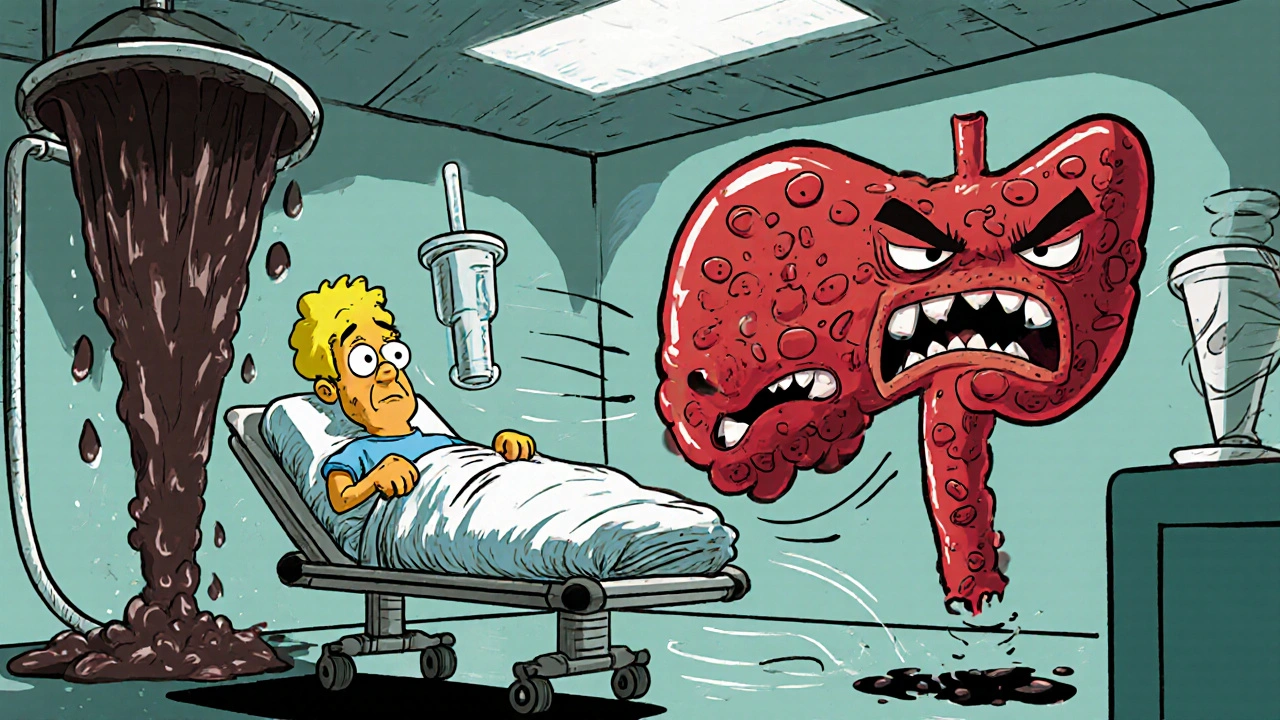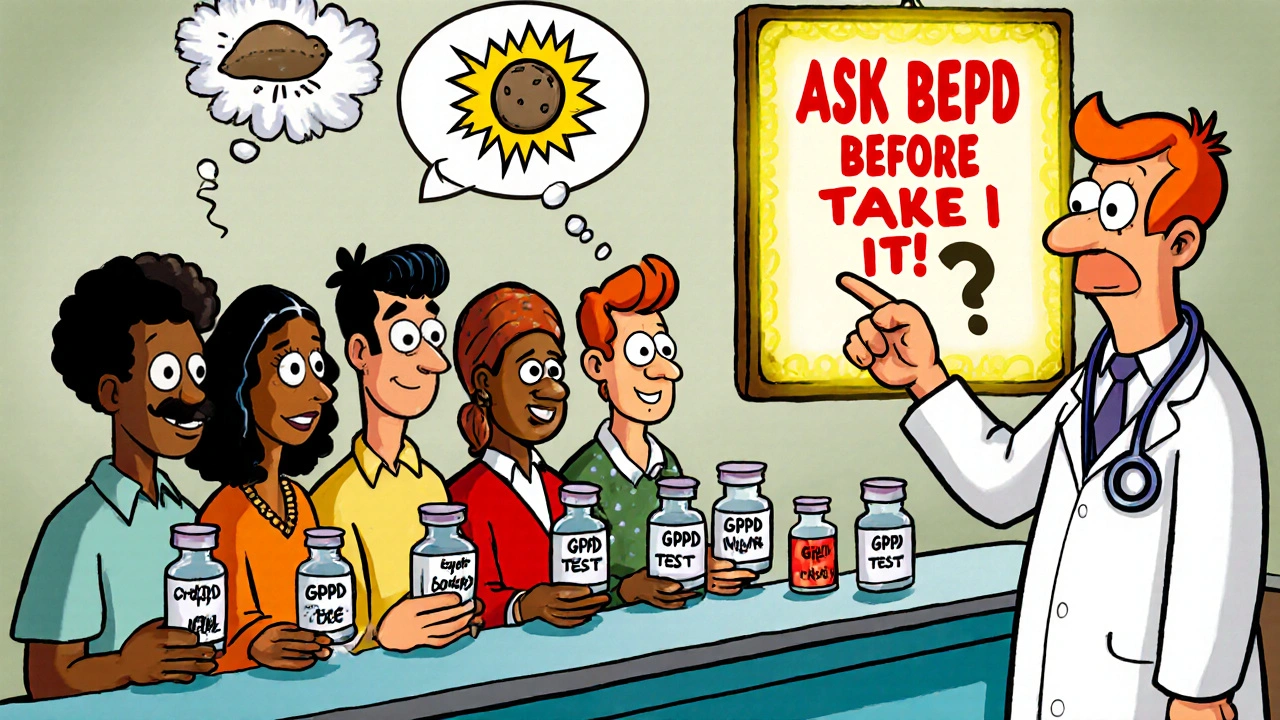
G6PD Risk Assessment Tool
Is Nitrofurantoin Safe for You?
This tool assesses your risk of hemolytic anemia when taking nitrofurantoin based on G6PD deficiency risk factors.
When you get a urinary tract infection (UTI), your doctor might reach for nitrofurantoin. It’s cheap, effective, and widely prescribed-over 5.5 million prescriptions in the U.S. alone each year. But for some people, this common antibiotic can trigger a dangerous, even life-threatening reaction: hemolytic anemia. And the biggest risk factor? A hidden genetic condition called G6PD deficiency.
What is G6PD deficiency, and why does it matter?
Glucose-6-phosphate dehydrogenase (G6PD) is an enzyme your red blood cells need to protect themselves from oxidative stress. If you’re deficient in this enzyme, your red blood cells can’t handle certain drugs, infections, or even fava beans. When exposed to oxidizing agents like nitrofurantoin, those cells break down too fast-leading to hemolytic anemia.This isn’t rare. Around 400 million people worldwide have G6PD deficiency, according to the World Health Organization. It’s most common in people of African, Mediterranean, Middle Eastern, and Southeast Asian descent. In Black African and African American populations, up to 14% are affected. In Mediterranean groups, it’s 4-7%. Yet, most people don’t know they have it until they take a drug like nitrofurantoin and suddenly feel terrible.
How nitrofurantoin triggers hemolysis
Nitrofurantoin works by creating reactive compounds in your urine that kill bacteria. But those same compounds don’t just target bacteria-they can also damage red blood cells. In healthy people, antioxidants like glutathione neutralize the damage. But in someone with G6PD deficiency, glutathione levels crash. Without it, hemoglobin inside red blood cells starts to clump, forming Heinz bodies. The spleen then destroys these damaged cells, leading to rapid anemia.Symptoms show up fast-usually within 24 to 72 hours of starting the drug. You might feel dizzy, have dark urine, jaundice (yellow skin or eyes), rapid heartbeat, or shortness of breath. In severe cases, you could develop fever, confusion, low blood pressure, or kidney damage. A 2023 case report in the National Center for Biotechnology Information described a patient whose hemoglobin dropped from 13.2 g/dL to 7.1 g/dL in just 48 hours after taking nitrofurantoin. He was hospitalized but recovered fully after stopping the drug and getting IV fluids.
The data doesn’t lie: it’s a real and documented danger
A 2022 review of medical literature found 42 confirmed or highly probable cases of nitrofurantoin-induced hemolytic anemia in G6PD-deficient patients. Ten of those cases ended in death. Another 24 cases were confirmed G6PD-deficient, with 4 highly probable. Eight of those cases involved pregnant women-some because they were taking nitrofurantoin themselves, others because the drug crossed the placenta. Three cases involved infants, two from maternal exposure during pregnancy.The Clinical Pharmacogenetics Implementation Consortium (CPIC), which sets drug safety guidelines based on genetics, says nitrofurantoin should be avoided entirely in G6PD-deficient patients who’ve had chronic hemolytic anemia. For others with G6PD deficiency but no prior complications, it’s still considered high-risk and should be used only if no alternatives exist.

Why isn’t everyone tested before taking it?
Here’s the problem: the FDA label for nitrofurantoin says it can cause hemolytic anemia in G6PD-deficient people-but it doesn’t require doctors to test for it first. Many clinicians don’t screen. A 2022 survey of 350 primary care doctors showed only 32% routinely check G6PD status before prescribing nitrofurantoin.Why? Cost, convenience, and lack of awareness. A G6PD test costs $35-$50. A hospital stay for hemolytic anemia? $8,500-$12,000. Yet, most doctors don’t think to ask about ancestry or family history. They assume their patient is “low risk.” But in Melbourne, Sydney, Toronto, or Los Angeles, you’re likely to see patients from high-prevalence backgrounds. Ignoring that is dangerous.
What are the safer alternatives?
If you have G6PD deficiency-or if your doctor suspects you might-there are better options for treating UTIs:- Fosfomycin (Monurol): A single-dose antibiotic, safe in G6PD deficiency, and effective against common UTI bugs like E. coli.
- Cephalexin: A first-generation cephalosporin with minimal oxidative risk.
- Amoxicillin-clavulanate: Often used for uncomplicated UTIs, especially if resistance is a concern.
- Pivmecillinam: Used in Europe and Canada, not available in the U.S., but has a strong safety profile in G6PD-deficient patients.
Trimethoprim-sulfamethoxazole (TMP-SMX) is another common UTI drug-but it’s also an oxidizing agent and can trigger hemolysis in G6PD-deficient people. So it’s not a safe alternative either.

Who should get tested before taking nitrofurantoin?
You should consider a G6PD test before taking nitrofurantoin if you:- Are of African, Mediterranean, Middle Eastern, or Southeast Asian descent
- Have a family history of anemia, jaundice, or blood transfusions
- Have had unexplained anemia after taking antibiotics or antimalarials
- Are pregnant and from a high-risk ethnic group
- Have had dark urine or fatigue after taking medications like sulfonamides or primaquine
Even if you’ve never had symptoms, you could still be G6PD-deficient. Half to 60% of people with the condition don’t know it until they have a hemolytic crisis. Testing is simple-a finger prick or blood draw. Results come back in hours.
What if you’re already taking nitrofurantoin?
If you start feeling unwell-dark urine, yellowing skin, extreme fatigue, or rapid heartbeat-stop the medication immediately. Call your doctor. Don’t wait. Hemolysis can escalate quickly. In most cases, stopping the drug and staying hydrated is enough. Blood transfusions are rarely needed unless the anemia is severe.Recovery usually happens within 3-5 days. One patient in a 2023 study saw his hemoglobin rebound from 7.1 g/dL to 12.5 g/dL in under a week after stopping nitrofurantoin and getting IV fluids. No transfusion. Just time and care.
What’s changing in 2025?
There’s growing pressure to make G6PD screening standard before prescribing nitrofurantoin. The NIH is running a multi-center trial (NCT04567891) to see if routine testing saves money and lives. Early results suggest it does. Point-of-care G6PD tests are now available in some clinics-results in 15 minutes. Insurance coverage is slowly improving.Meanwhile, electronic health records are starting to add alerts. If you’re flagged as African, Middle Eastern, or Southeast Asian descent, your doctor’s system might now pop up a warning: “Avoid nitrofurantoin-consider G6PD testing.” That’s progress.
But until universal screening becomes law, the responsibility falls on you. If you’re from a high-risk group, ask your doctor: “Could I have G6PD deficiency? Should I get tested before taking this antibiotic?”
Nitrofurantoin isn’t going away. It’s still one of the best tools we have against resistant UTIs. But it’s not safe for everyone. Knowing your status isn’t just smart-it could save your life.




May Zone skelah
October 28, 2025Okay so let me just say this-this post is basically the medical equivalent of a Netflix documentary that makes you feel like you’ve been lied to your whole life. I mean, nitrofurantoin? The go-to for UTIs? The one your grandma swears by? Turns out it’s basically a silent assassin for people who look like me. And no one told us. Not the ER doc. Not the pharmacist. Not even the damn label on the bottle. I’m African American. I’ve taken this stuff three times. I’ve had dark urine after every course. I thought it was just dehydration. Turns out it was my red blood cells screaming for help. This isn’t just a medical oversight-it’s systemic neglect. And now I’m mad. And scared. And honestly? I’m not the only one.
Why do we only talk about this after someone almost dies? Why isn’t this on every prescription bottle? Why isn’t it in the first line of the patient info? This isn’t rare. It’s epidemic. And we’re all just waiting for the next person to collapse in the pharmacy aisle because no one bothered to ask if they were from somewhere.
I’m starting a petition. #TestBeforeYouPrescribe. Tag your doctor. Tag your pharmacist. Tag your mom. We’re done being the quiet minority that gets poisoned by convenience.
Also-fava beans? Yeah, I ate those as a kid. Never had a problem. But nitrofurantoin? One pill and I’m in the ER. So maybe the real issue isn’t the beans. It’s the arrogance of Western medicine thinking it knows better than biology.
Dale Yu
October 29, 2025why do doctors still prescribe this shit
its 2025 and we still dont test for g6pd
people are dying for no reason
its not hard to do a blood test
its cheaper than a hospital stay
so why dont they
its lazy and racist
Kshitij Nim
October 29, 2025As someone from India where G6PD deficiency is super common, I’ve seen this firsthand. My cousin had a bad reaction to an antibiotic years ago-turned out it was nitrofurantoin. He was in the hospital for a week. No one even asked about family history. The doctor just assumed he was ‘low risk’ because he lived in a city.
But here’s the thing-this isn’t just about nitrofurantoin. It’s about how medicine treats genetic risks like they’re optional. We test for everything else-pregnancy, allergies, blood type. Why not this? It’s a simple finger prick. Takes five minutes.
And to the doctors reading this: if you’re not screening people of African, South Asian, or Mediterranean descent before prescribing this drug, you’re not being careful-you’re being negligent. I’ve seen too many people suffer because ‘it’s not routine.’ It should be.
Also, fosfomycin is a game-changer. I’ve been pushing it in my clinic for years. It works just as well, no hemolysis risk. Why aren’t more of you using it?
Scott Horvath
October 31, 2025man i had no idea this was a thing
my mom took this for a uti last year and got super yellow and tired
we thought it was just the flu
turns out she’s g6pd deficient
she never knew
she’s mexican and hispanic and no one ever asked
so now i’m telling everyone i know
ask your doctor before you take any antibiotic
its not just about allergies
its about your blood
and if you’re from anywhere with sun and history
you might be at risk
and its not your fault
its the system
Armando Rodriguez
November 2, 2025This is an exceptionally well-researched and urgently important piece of public health information. The data presented is not only compelling but also deeply concerning from an ethical standpoint. The fact that a drug with such a well-documented risk profile remains routinely prescribed without mandatory screening suggests a systemic failure in clinical education and policy implementation.
The Clinical Pharmacogenetics Implementation Consortium guidelines are clear. The NIH trial is promising. Point-of-care testing is now feasible. What remains is political will and institutional accountability. Healthcare institutions must adopt standardized protocols for G6PD screening in high-risk populations before prescribing oxidizing agents like nitrofurantoin. This is not a matter of preference-it is a matter of patient safety.
Furthermore, the cost-benefit analysis is unequivocal: $50 for a test versus $10,000 for hospitalization. Preventive care is not an expense-it is an investment. We must prioritize equity in pharmacogenomics. This is not just about genetics-it’s about justice.
jennifer sizemore
November 2, 2025thank you for writing this
i’ve had three utis in the last two years and every time i got nitrofurantoin
and every time i felt awful for a few days
dark urine
headache
super tired
i thought it was just the infection
but now i realize it was my body reacting
i’m half filipina and my grandma had anemia
so i’m getting tested tomorrow
and if i’m deficient
i’m making sure every doctor i ever see knows
no one should have to suffer like this because no one asked
matt tricarico
November 2, 2025Let’s be honest-this isn’t about G6PD deficiency. It’s about the pharmaceutical industry’s indifference. Nitrofurantoin is cheap. It’s profitable. And it’s been around since the 1950s. No one’s going to patent a screening test. No one’s going to make money off of telling doctors to stop prescribing it.
The FDA? They’re asleep at the wheel. The AMA? Too busy lobbying. The doctors? Too lazy to learn genetics.
This isn’t negligence. It’s capitalism. And until someone sues the FDA for failing to mandate testing, nothing will change. The fact that this is still legal? It’s a crime. And the people dying? They’re just collateral damage in a system that values profit over life.
Next time you take an antibiotic, ask yourself: who benefits? And who pays?
Patrick Ezebube
November 3, 2025they’ve been hiding this for decades
the CDC knows
the WHO knows
the drug companies know
they let millions of people take this drug knowing it kills
and now they’re pretending it’s just ‘rare’
it’s not rare
it’s covered up
they don’t want you to know
because if you knew
you’d stop buying it
and they’d lose billions
the ‘test before you prescribe’ movement? it’s a distraction
they’re not going to change the system
they’re just going to make you feel better about getting tested
while they keep selling the poison
you think this is about medicine?
it’s about control
and you’re the lab rat
Kimberly Ford
November 4, 2025I’m a nurse practitioner and I’ve been pushing for G6PD screening since 2020. I’ve had patients come in with hemolytic anemia after nitrofurantoin-and I had to explain to them that it was preventable.
Here’s what I do now: if you’re Black, Latino, Middle Eastern, Southeast Asian, or have a family history of anemia or jaundice-I screen you. No questions. No assumptions. Just a quick finger prick. Results in 15 minutes. I bill it as ‘routine risk assessment.’
And guess what? My patients love it. They feel seen. They feel safe.
And here’s the kicker-I’ve switched 80% of my UTI prescriptions to fosfomycin or cephalexin. Same success rate. Zero hemolysis. Less ER visits. Less stress. Less cost.
If you’re a provider reading this: you don’t need permission to do the right thing. You just need to start.
And if you’re a patient? Ask. Even if they say no. Ask again.
You deserve to know what’s in your blood.
jerry woo
November 6, 2025so nitrofurantoin is basically the opioid of antibiotics
cheap
easy
profitable
and it’s slowly killing people who don’t even know they’re vulnerable
and the system? it’s not broken
it’s working exactly as designed
they don’t care if you bleed out from the inside
as long as the prescription gets filled
and the insurance gets billed
and the pharmacy gets its cut
they’ll keep pushing it
until someone sues them into oblivion
or until a whole generation of people starts dying in their 30s
and then maybe-just maybe-they’ll pause
but by then it’ll be too late
and they’ll just launch a new drug
and call it ‘innovative’
and we’ll do it all again
Jillian Fisher
November 7, 2025i’ve never heard of this before but now i’m scared
my dad is from pakistan and he gets UTIs all the time
he’s been on this antibiotic for years
should i tell him to get tested?
is it too late?